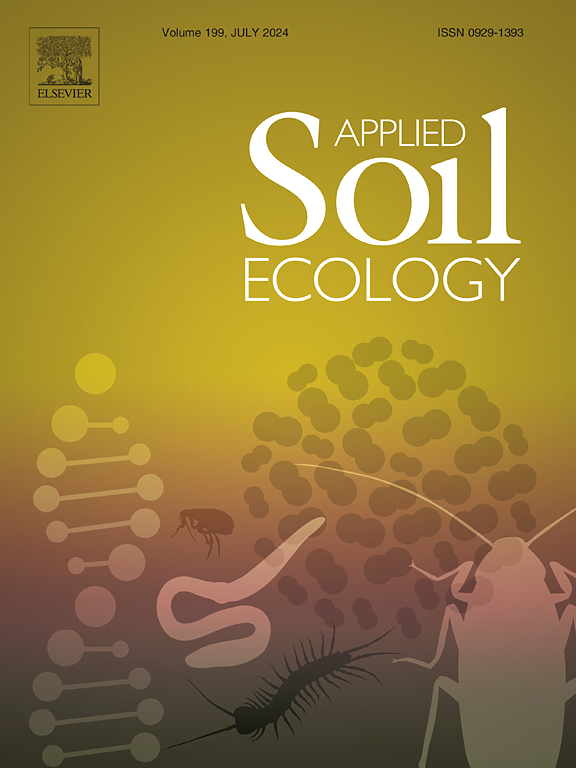Effects of soil microorganisms on aggregate stability during vegetation recovery in degraded granitic red soil areas
IF 4.8
2区 农林科学
Q1 SOIL SCIENCE
引用次数: 0
Abstract
Soil aggregates determine the soil structure, and the various cementitious substances produced by microorganisms can affect the composition and stability of soil aggregates. Currently, the characteristics of soil microorganisms and the mechanisms of aggregate stability during vegetation restoration in granite erosion areas remain unclear. In this study, the following five vegetation restoration stages in erosion zones were examined: bare land (LD), grassland (CD), grassland–shrub transition land (CG), shrubland (GM), and secondary forest (CS). By analyzing the relationships among the microbial community structure, aggregate stability, and soil physicochemical properties, the key factors influencing soil aggregate stability were identified. The findings revealed that with vegetation restoration, the stability of soil aggregates (mean weight diameter (MWD) and geometric mean diameter (GMD)) and the content of water-stable aggregates larger than 0.25 mm (WR0.25) increased, and the stability was greater in the soil surface layer than in the subsurface layer. High-throughput sequencing demonstrated a notable increase in the Shannon diversity index and richness index of the soil microorganisms in the soil surface layer compared with those at the LD stage. Pearson correlation analysis revealed positive associations between the soil aggregate stability and the abundance and diversity of soil bacteria, archaea, and nutrients such as soil organic carbon (SOC), total nitrogen (TN), total phosphorus (TP), and available nitrogen (AN). The redundancy analysis results indicated that the relative abundance of key phyla such as Thermoplasmatota, Ascomycota, Actinobacteriota, and Proteobacteria, along with the α diversity of bacteria and archaea in the soil surface layer, accounted for 85.90 % of the overall formation and stabilization of soil aggregates with particle sizes of 2 mm and 1–2 mm. Notably, Actinobacteriota was the primary contributor, explaining 82.6 % of the total variance in the soil aggregate stability. Actinobacteriota also significantly increased the soil nutrient content and aggregate stability. These findings provide an important scientific basis for soil quality improvement in granite erosion areas.
退化花岗岩红壤地区植被恢复期间土壤微生物对聚合稳定性的影响
土壤团聚体决定了土壤结构,而微生物产生的各种胶凝物质会影响土壤团聚体的组成和稳定性。目前,花岗岩侵蚀区植被恢复过程中土壤微生物的特征和骨料稳定性的机制仍不清楚。本研究考察了侵蚀区的以下五个植被恢复阶段:裸地(LD)、草地(CD)、草地-灌木过渡地(CG)、灌木地(GM)和次生林(CS)。通过分析微生物群落结构、团聚体稳定性和土壤理化性质之间的关系,确定了影响土壤团聚体稳定性的关键因素。研究结果表明,随着植被的恢复,土壤团聚体的稳定性(平均重量直径(MWD)和几何平均直径(GMD))和大于 0.25 毫米(WR0.25)的水稳团聚体的含量都有所增加,而且土壤表层的稳定性高于地下层。高通量测序表明,与 LD 阶段相比,土壤表层土壤微生物的香农多样性指数和丰富度指数显著增加。皮尔逊相关分析表明,土壤团聚体稳定性与土壤细菌、古菌的丰度和多样性以及土壤有机碳(SOC)、全氮(TN)、全磷(TP)和可利用氮(AN)等养分之间存在正相关。冗余分析结果表明,土壤表层中热菌群、子囊菌群、放线菌群和蛋白菌群等关键菌门的相对丰度,以及细菌和古细菌的α多样性,在粒径为 2 毫米和 1-2 毫米的土壤团聚体的整体形成和稳定过程中占 85.90%。值得注意的是,放线菌群是主要贡献者,占土壤团聚体稳定性总变异的 82.6%。放线菌群还能显著提高土壤养分含量和聚合稳定性。这些发现为改善花岗岩侵蚀地区的土壤质量提供了重要的科学依据。
本文章由计算机程序翻译,如有差异,请以英文原文为准。
求助全文
约1分钟内获得全文
求助全文
来源期刊

Applied Soil Ecology
农林科学-土壤科学
CiteScore
9.70
自引率
4.20%
发文量
363
审稿时长
5.3 months
期刊介绍:
Applied Soil Ecology addresses the role of soil organisms and their interactions in relation to: sustainability and productivity, nutrient cycling and other soil processes, the maintenance of soil functions, the impact of human activities on soil ecosystems and bio(techno)logical control of soil-inhabiting pests, diseases and weeds.
 求助内容:
求助内容: 应助结果提醒方式:
应助结果提醒方式:


